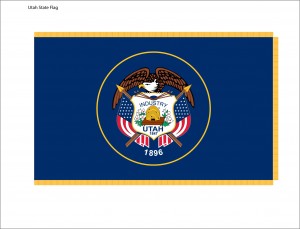Meaning of the Symbols on the Utah State Flag
The design of the Utah State flag incorporates the emblems found on the Great Seal of the Utah which are placed on a blue field. This is a common pattern used for many of our state flags, and while some critics complain that the design of state flags should be more distinctive—the Utah State flag has a long and rich history to recommend and its design reflects the state’s heritage.
The Great Seal of Utah adopted in 1896 is a product of the time and tells us how Utahns of that day saw themselves, and perhaps more importantly, how they wanted the rest of the nation and the world to view them. The design of the State Seal was later incorporated into the design of the Utah State flag. Examination of the flag’s design can give us insight about Utah, its history and its peoples.
![]()
![]() When creating a device for the Great Seal of Utah in 1896 designers took the seal of the Utah Territory, and placed its central device on a shield that they placed in the center of the flag. The beehive is a symbol evoking the Provisional State of Deseret, which Congress rejected repeatedly. Yet more importantly the beehive is a meaningful symbol of the pioneers’ early existence in the Great Basin. These settlers were a self-sufficient community filling all their needs from the local sources as does a bee colony living in a hive. As if they were placing new hives, settlements were founded and placed up and down the corridor from Salt Lake north to Canada and south to Las Vegas. The histories of the pioneer settlements, of the provisional State of Deseret and of Utah’s days as a U.S. territory are all reflected in the symbol of the Beehive which is—appropriately—at the center of the seal and the flag
When creating a device for the Great Seal of Utah in 1896 designers took the seal of the Utah Territory, and placed its central device on a shield that they placed in the center of the flag. The beehive is a symbol evoking the Provisional State of Deseret, which Congress rejected repeatedly. Yet more importantly the beehive is a meaningful symbol of the pioneers’ early existence in the Great Basin. These settlers were a self-sufficient community filling all their needs from the local sources as does a bee colony living in a hive. As if they were placing new hives, settlements were founded and placed up and down the corridor from Salt Lake north to Canada and south to Las Vegas. The histories of the pioneer settlements, of the provisional State of Deseret and of Utah’s days as a U.S. territory are all reflected in the symbol of the Beehive which is—appropriately—at the center of the seal and the flag
![]() The sego lilies are native flowers from which the bees gathered their sustenance just as the Pioneers had to produce their cops locally. The Ute Indians who lived in the area taught early Mormon settlers how to eat sego lily bulbs it times when food was scarce.
The sego lilies are native flowers from which the bees gathered their sustenance just as the Pioneers had to produce their cops locally. The Ute Indians who lived in the area taught early Mormon settlers how to eat sego lily bulbs it times when food was scarce.
The motto industry, together with the hive, represented the hard work required to survive in what was then a harsh and unfriendly environment. Not just to survive, but to make the desert “blossom as a rose” (Isaiah 35:1). Today the word industry has narrowed in meaning to represent factories and manufacturing; however, in the nineteenth century industry was defined as the hard work needed to produce results.
The name Utah, forced on the settlers since Congress did not like the name Deseret because of its origin in the Book of Mormon, is a Ute Indian word roughly meaning “people who live higher up in the mountains.”
The six arrows piercing the shield remembered the six native tribes that inhabited Deseret before the coming of the pioneers. Like the boundaries of the Provisional State of Deseret, the lands of these native peoples are not by the boundaries of the present day state. Rather, the state lines are like a cookie cutter pressed into the rolled out dough of larger lands. These boundaries were produced as Congress repeatedly cut off portions of the Provisional State of Deseret and later of Utah Territory to create neighboring states while ignoring petitions from the would be citizens of Deseret and Utah Territory.
While there were several reasons for Congress’ repeated refusals of petitions for statehood, the fact was also that these settlers were an unpopular minority that Congress did not want to admit on equal ground with the citizens of other states.
The years 1847 and 1896 define a period in Utah history known locally as the struggle for statehood. So, in 1896 when Utah finally achieved statehood–the placement of the American Eagle and the crossed flags behind the shield announced to the nation and the world: “Despite all opposition, we made it, Utah is finally a state.”
Today a full color design adopted a century ago and based on the Utah’s state seal sits at the center of the Utah State flag. The symbols on the flag will recount Utah’s history for those who examine it.



